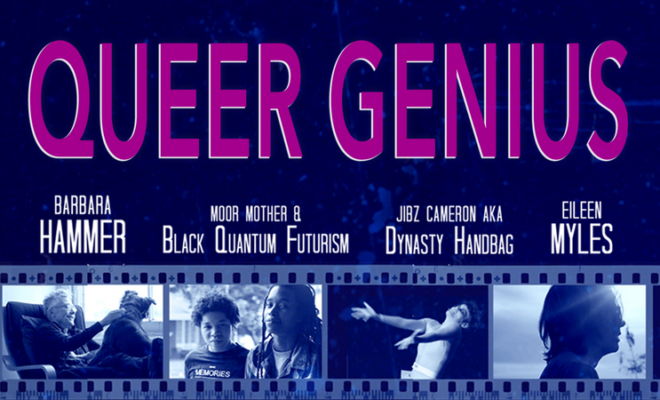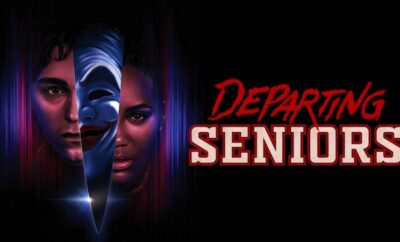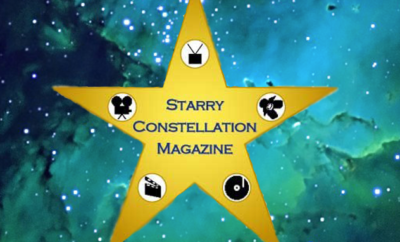
Movie Reviews
Queer Genius
By: Kelly Kearney
What does it mean to be a “Queer Genius?” Is it art partnered with fame and pigeonholed in identity? Can the two exist separately inside one living vessel, transcending time and human mortality? The documentary Queer Genius, directed by Chet Pancake, explores these questions by breaking down the defining barriers of queerness and examining how it can influence, create, inspire, inform and even at times trap us in a box of expectations. In an in-depth series of interviews with five Queer visionaries Barbara Hammer, Black Quantum Futurism with Rasheeda Phillips and Moor Mother, Dynasty Handbag / Jibz Cameron and Eileen Myles the film explores the most intimate stories of their tragedies and their triumphs, as they take us on a vulnerable journey down a path of queer perspective-crossing generations, race, politics and time.
Queer Mortality and Afro-futurism
Queer Genius takes us into five artist’s homes where they talk about their life’s work and what it means to be a genius. For artist and filmmaker Barbara Hammer, it meant opening the closet on four decades of queer filmmaking and recorded activism, beginning in the ‘70s, with her 8mm film Superdyke Meets Madame X. Over the span of forty years Hammer dissects lesbian queer existence from sex to politics as one of the leaders of a movement hidden in plain sight and brought to light by a passion to be recognized and a need for community. In the segment filled with flashbacks interwoven with the end of her life in 2019, Barbara takes us through her own understanding of what queer genius means through the lens of female sexual exploration and how the idea that lesbianism, in and of itself, is a form of activism. As with all the artists featured in this film, Barbara’s work thrived in oppression. Beginning at the start of the women’s liberation movement with sensual black and white movies depicting female sexuality, Hammer’s art found a rebirth during the height of the AIDS epidemic and again when technology opened new doors in filming formats. From her early work depicting the tenderness of sex to her more recent film A Horse is Not a Metaphor, Hammer managed to capture a sensuous rage combined with the crippling fears of an incurable cancer diagnosis to which only a woman could relate. Her work is seen today as a considerable outlet for sexual expression in a time when the very idea was forbidden – at least on film and in public. What was a form of media mostly circulating throughout city art houses and lesbian word of mouth, is now celebrated in the mainstream and preserved for museums and Universities as an historical account of Queerdom? History is queer and Barbara Hammer was as much a historian as she was a queer artist, not unlike the second segment in the film which focuses on speculative fiction in afro-futurism from within the queer gaze.
Lawyer, poet and activist Rasheeda Phillips along with her partner and music collaborator Camae Ayewa a/k/a Moor Mother created a project called “Black Quantum Futurism,” combining music, sci-fi narratives, film, poetry, theater and community in Northern Philadelphia. BQF, as Rasheeda explains, is the theory of entangled timelines based on many human perspectives operating simultaneously and separate from each other. While seeped in the science of quantum physics, BQF is told through a fictional narrative that projects those future timelines and searches for ways to combine them into one collective present for all to experience. Working with groups like queer sci-fi collective Metropolarity, Rasheeda was able to focus on the systemic racism of the North Philly experience as it relates to the displacement of impoverished families, many of whom she represents in her work as an attorney for low-income tenants. As we catch glimpses her performance both on stage and in court, her BQF poses the question: “At what time did we become free?” exploring the idea of time’s non-existence inside a system of oppression and subjugation. If time only moves forward through the markers of change but oppression prohibits change, then time must collapse into itself- funneling down through its own black hole and returning to the very moment in time where it all began. No change – no growth, just pre-determined repetitive outcomes serving a purpose only for the privileged. As told throughout her interviews, Rasheeda’s performative art was born out of the Black Queer experience and with it came an idea for a safe space where people in her community could gather to discuss their concerns about the future of their neighborhood. Partnering with Mother Moor, who translates BFQ’s on-stage time travel into sound, the two opened a Space Community Futures Lab in an attempt to bridge the gap between art, activism and community outreach. This safe space, we learn from Camae, is as old as the African Methodist hymns she was raised on. It’s activism-into energy-into art and it’s genius comes from its innovative ways of sharing information. Emotions, experience, lyrics, music, story, and community relayed a message of perseverance to her ancestors, and for Camae and Rasheeda, those messages are most influential to their art and their life partnership today. Separately the two are queer artists searching for their genius, but together, they’ve found the key to the ultimate quantum jump: love and falling into it can collapse time and create a present separate from the past and future.
The Female Experience and Queer Dogs
On another spectrum of queer performance art, the film heads to Los Angeles where we meet comedian and visual, sound and performance artist Jibz Cameron. Jibz is the fourth artist sharing their life’s work as she opens the closet, quite literally, on her one woman show and alter-stage-ego, Dynasty Handbag. Dynasty is the manifestation of the female experience, or as Jibz explains “a comedy-tragedy-meltdown performance vehicle in the flesh.” In a vulnerable recount of her life, Jibz discusses what it was like to be raised in an artist commune, abandoned by her mother as a teenager and the battles of addiction she waged that led to a marriage and divorce all before the age of twenty-four. It was a journey that left her bereft of artistic drive. “A culture of failure,” as she describes, is what gripped her and sent her back into the creative closet where ingenuity remained just out of reach. In that time, she created Dynasty Handbag, her alternate being, and used her as a mechanism to understand her own role as a queer woman. As the interview cuts between Jibz in her apartment picking through Dynasty’s wardrobe, videos of her childhood at Wavy Gravy’s hippie art camp and her stage performance meltdowns, we see her art has now taken on new venture with Jack Black in the collaborative Electric Dynamite Project Development. Now Jibz makes art because she chooses to not because she is expected to or feels she has to. In that freedom to create she’s found her genius and for some, like poet Eileen Myles, it’s inspiring.
In a Lower Eastside apartment, we find the final artist unraveling the idea of Queer Genius. As poet and one-time Presidential candidate, Eileen Myles points out a drawing hanging on their kitchen wall done by none other than Jibz Cameron. Immediately you get the sense that genius can and should be communal – a shared experience connecting queer creatives. As Myles walks their dog, which they admit has always seemed queer to them, they read through decades of work and touch on the realization that success can pigeonhole you into a defining label that smothers artistry. “Be your own hero. You don’t have to be Emily Dickenson,” a video of a younger Myles preaches to a room full of hungry literary twenty-somethings. It’s the trauma of femaleness that creates art and Myles, who was raised by alcoholics and later became an addict themselves, uses societies ignorance as fuel for their pen. Segueing from poetry to prose using snippets of their work from their famed book Chelsea Girls back-to-back with videos of the time they ran for President, Myles legacy has been labeled as “other” and “genius” where they would just like to be remembered as artist – sans “icon” or “lesbian” prefixes. Success as a Queer labeled poet isn’t a double-edged sword, it’s a dagger in the back of human experience and throughout their interview we get the sense Myles has been slowly extracting that blade for decades. What is art if not the expression of that human experience? It’s a surreal vacation from the expectations that can hang around the neck of a creator, like a noose, slowly tightening the passion right out of the work. Myles, who is arguably the most known voice of the New York misfits, feminists and modern Queer poets, contextualized Queer Genius not as the box an identity forces you into but in the act of existing in one’s truth, a truth that’s ever changing and malleable whether or not it’s in the box or out of it.
Defining what Queer Genius is seems to differ between the artists and that is where the documentary might falter, but perhaps leaving it undefined is the point. Transcending the narratives of personal and sexual identities is an esoteric philosophy that might get lost on viewers who search for an all-encompassing meaning to the title of the film. Where director Pancake succeeds is in their efforts to seamlessly tie the past to the present without ever shying away from the uncomfortable and sometimes titillating truth: that history has always been queer – as it belongs to the storytellers, the artists and the purveyors of truth who document the present like a guidebook for the future. Art is history, it is activism, it is memory, and it is linear in an unstructured world. It is battles waged and wars won, it is the human experience, it is sex, it is oppression, it is queer expression, and it is vital to the future of queerkind.
Queer Genius is an excellent vehicle for artists, intellectuals and those who just want to take a ride through contemporary queer art. It informs without ever insulting the viewer’s past knowledge and offers an experience that many women can recognize as their own. In its intimate expressions of love, for each other, oneself and for the work, the documentary paints a picture of the many diverse angles to view the queerness of a genius and would be enjoyed by anyone who embraces art as a form of activism.





You must be logged in to post a comment Login